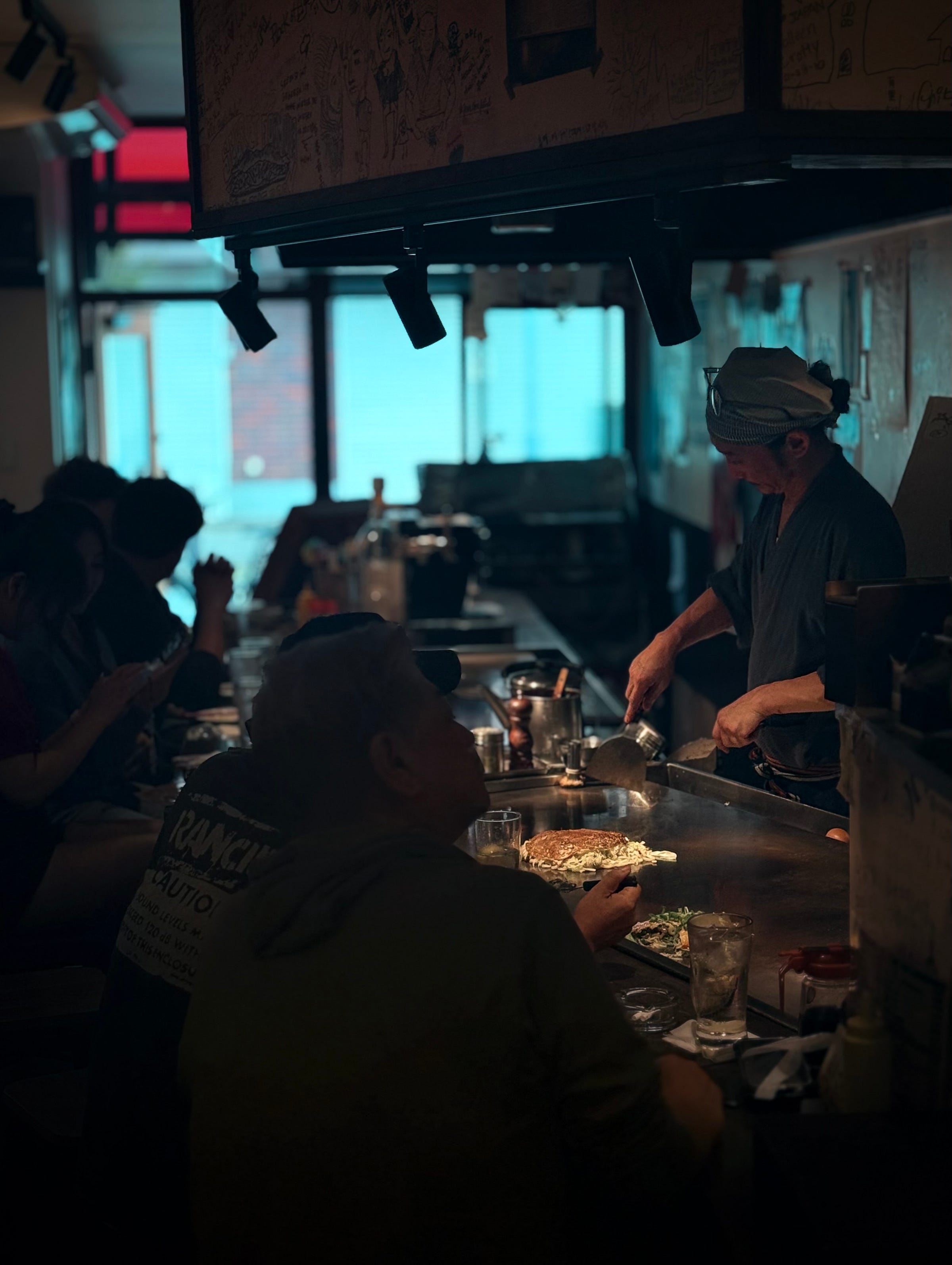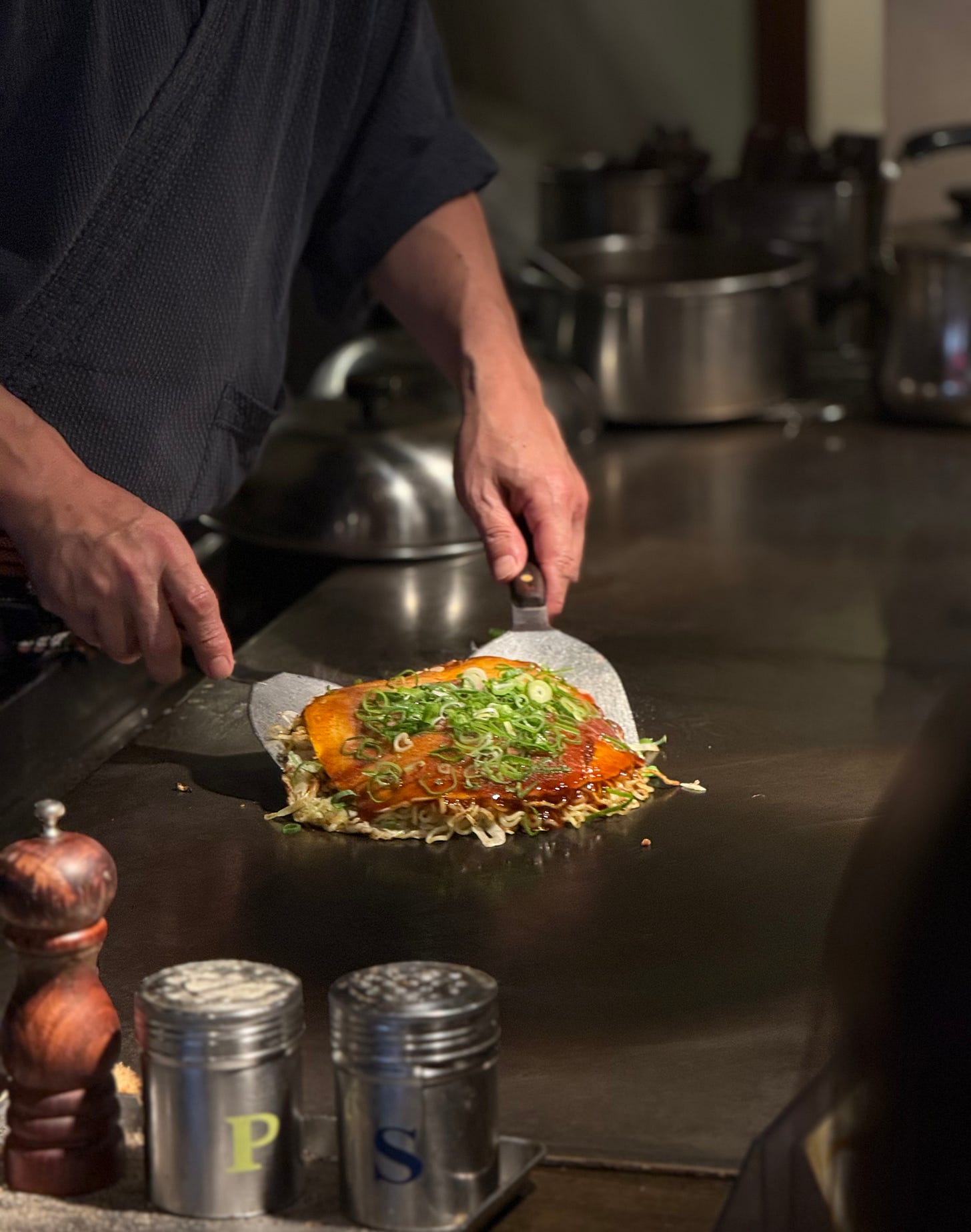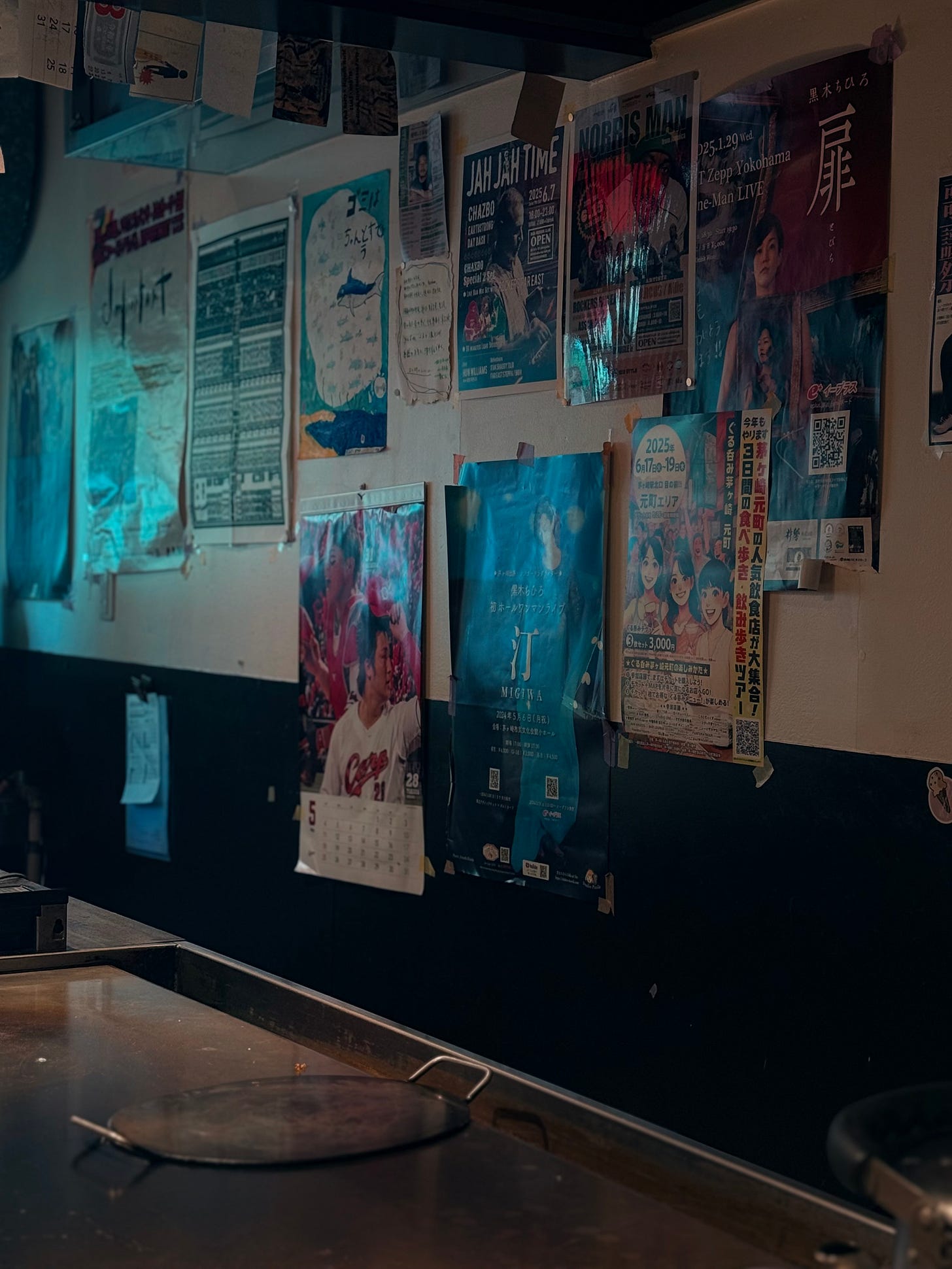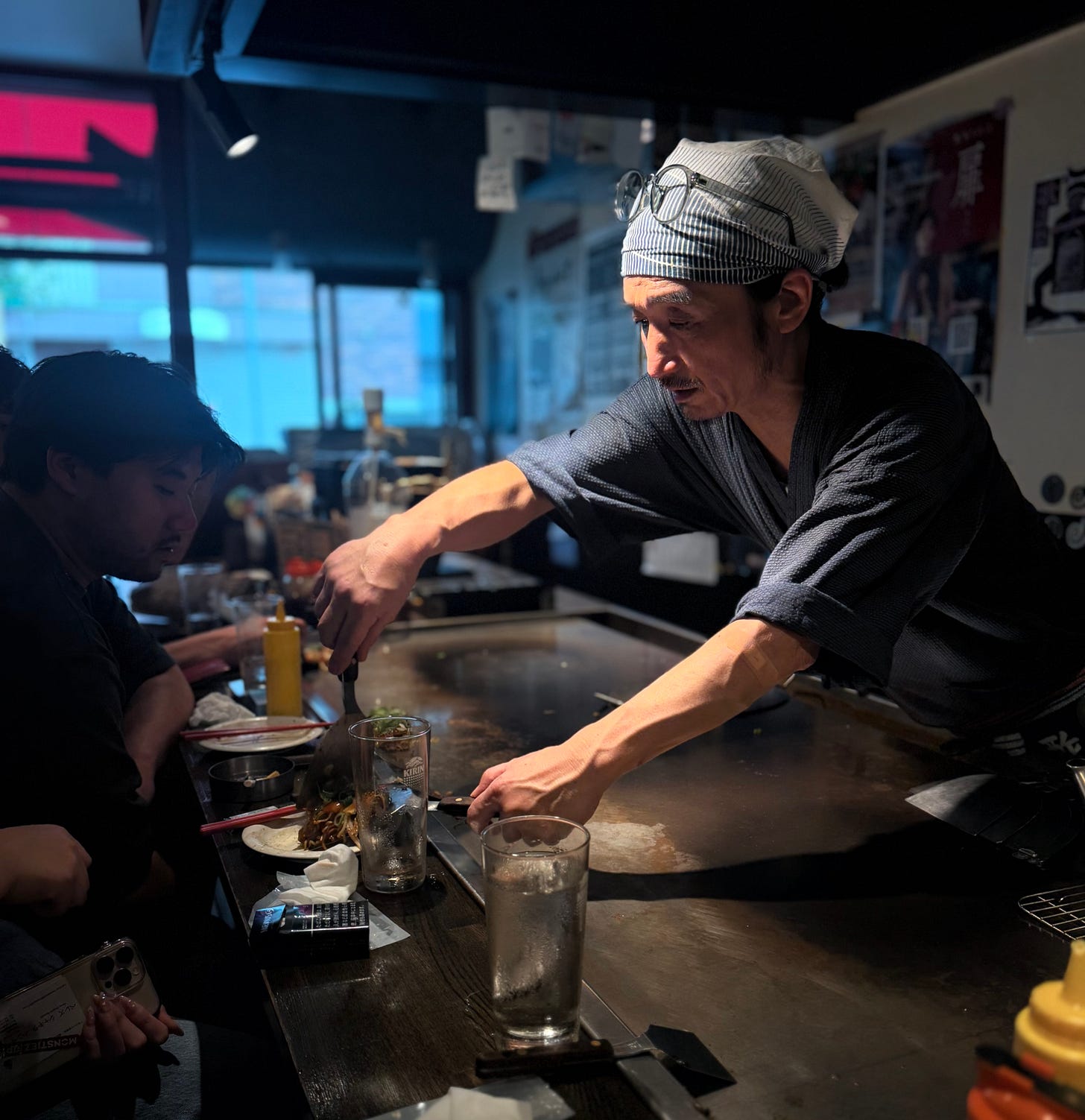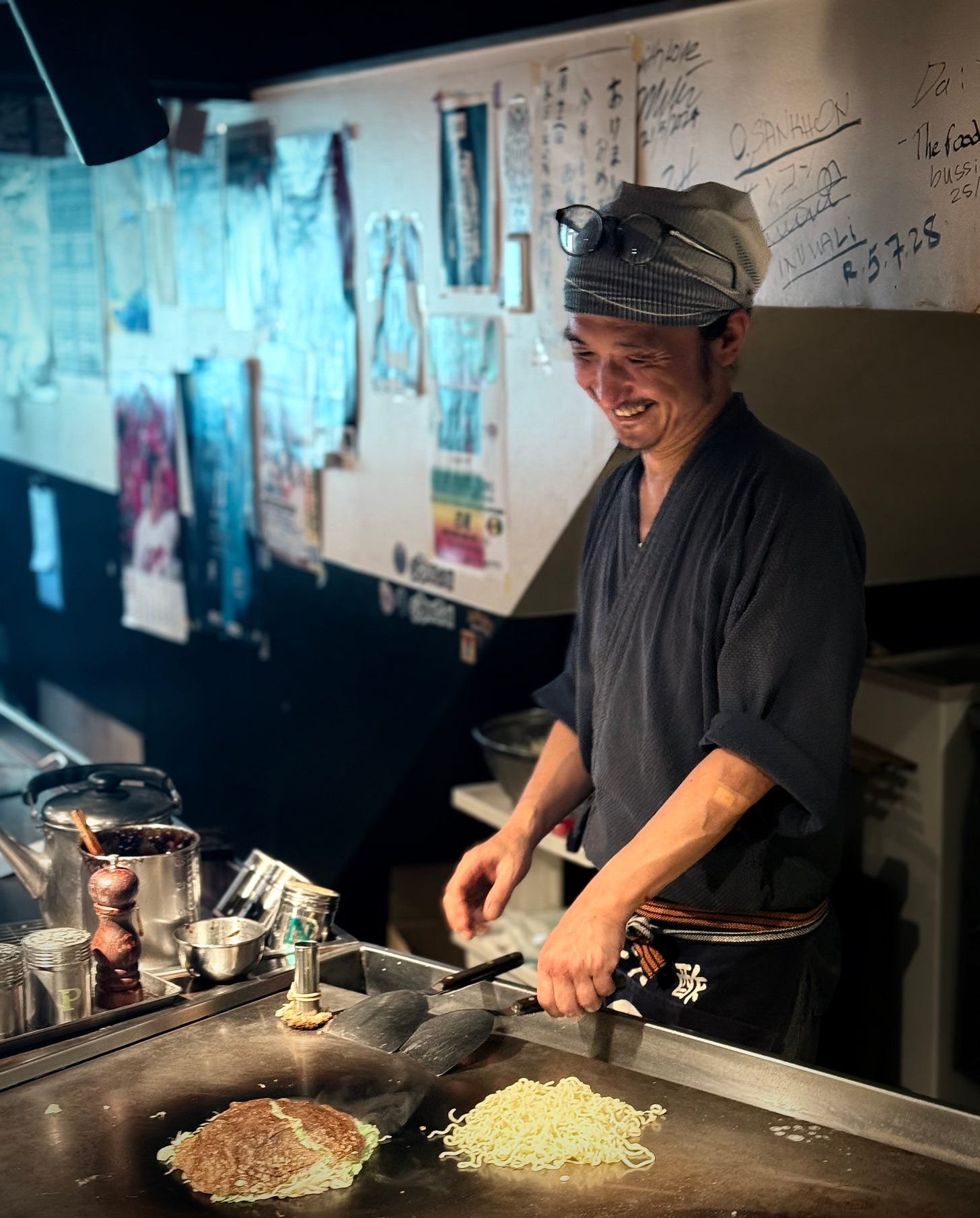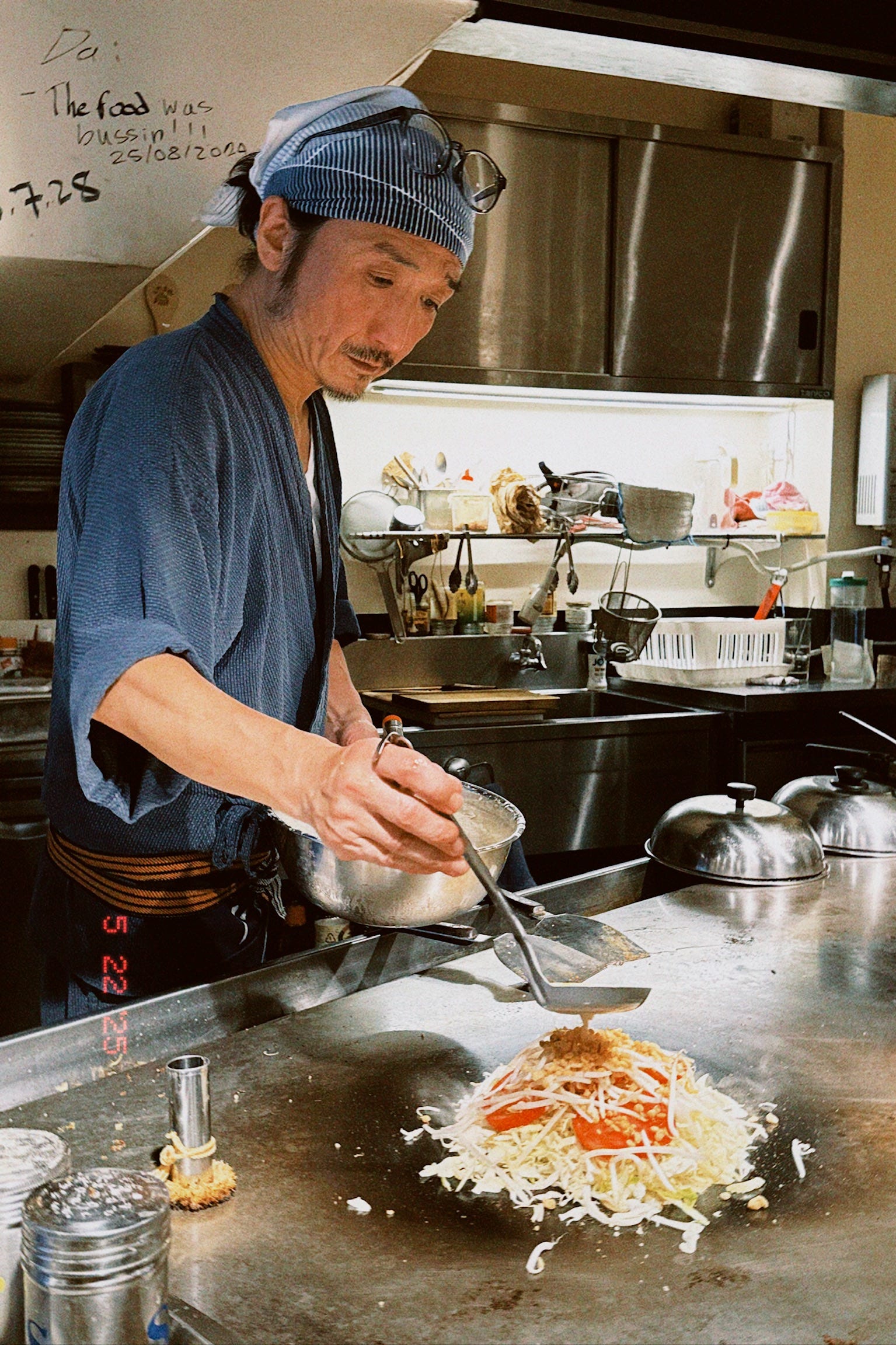Japanese Food: The Story of Taka-san and AnAn
by Erik Evans, Gong Rui, SANO, Arii (Arisa)
Picture 1: Long Shot of the entire restaurant with customers putting spotlight on Taka-san and setting the mood and environment.
Picture 2: Close Up Shot Taka-san displaying freshly made Hiroshima-style Okonomiyaki garnished with green onion and prepared with crispy yakisoba noodles on the bottom which give it’s iconic Hiroshima characteristic.
Picture 3: Close Up shot of the back wall which gives the restaurant its unique charm through a diverse and carefully curated selection of posters and handwritten notes.
Picture 4: Medium shot of the Taka-san, a customer which shows the intimate interactions between chef and customer.
Picture 5: Medium shot of Taka-san cooking the okonomiyaki which highlights a candid moment of warmth and hospitality when serving us.
Picture 6: Medium shot of Taka-san pouring okonomiyaki batter over a pile of shredded cabbage, bean sprouts, and tomato which captures the preparation process of the dish.
The Story of Taka-san and AnAn
Our group decided to choose Japanese food for our topic because we were all passionate about food and thought it would be a really great experience to learn about the diverse experiences of a Japanese restaurant owner. We interviewed Taka-san who is the owner and chef of 杏庵 (AnAn), a cozy okonomiyaki restaurant located in Chigasaki. Originally from Hiroshima, he brings a deep connection to the dish, blending regional styles with his own creative touch. Before opening AnAn in 1999, he explored different paths—from working briefly in a company to spending several years as a painter. His journey into the food world wasn’t planned, but through exploration and mentorship, he discovered a new passion. For 26 years, Taka-san has run AnAn on his own, creating delicious food where locals can enjoy the warm and welcoming environment.
杏庵(あんあん/AnAn)
Owner: Taka
Meaning of the Kanji:
杏=apricot /あんず
案=a small house where everyone is welcome
1.) When did you start the restaurant? いつはじめたのですか?
1999
2.) What did you do before opening the restaurant?飲食業界始まる前はどんなしごとをしていましたか?
Before opening the restaurant, Taka-san went through a few different phases in life. After graduating from university, he joined a company, but soon realized it wasn’t for him and left shortly after. He then pursued life as a painter for three years. During that period, he spent a lot of time reflecting on what kind of work felt meaningful and sustainable for him. He began exploring different options.
Being from Hiroshima, he had a deep-rooted connection to okonomiyaki, which is beloved in the region. However, after trying various okonomiyaki restaurants in Chigasaki, he noticed that something was missing. It just didn’t match the flavors and spirit of what he grew up with. That realization sparked the idea: what if he created his own version of okonomiyaki? Not just a replica of Hiroshima-style, but something that honored the best aspects of different regional styles — blending them into a unique dish that reflects his personal journey. That’s how the idea for his restaurant was born — to create an okonomiyaki that represents both his roots and his uniqueness.
3.) Did you think of having a restaurant as a dream when you were a kid? 小さいときはレストランを開く夢はありましたか?
As a child, Taka-san actually dreamed of becoming a construction worker and not a chef or a business owner. The idea of running a restaurant wasn't something he planned at all. As he grew older and explored different passions, his career evolved in ways he never imagined. This shift in direction became a reminder that it’s okay when your future aspirations change and that sometimes, the path you didn't plan turns out to be the one that suits you best. For Taka-san, discovering a new passion for okonomiyaki and sharing it with others could have potentially been more fulfilling than anything he had envisioned as a kid.
4.) Was there a mentor or teacher who taught you to open a restaurant? レストランを開くのに、教えてくださった先生とかはいましたか?
Yes, his sensei was in Hiroshima.This mentor helped him understand what makes okonomiyaki great and gave him the confidence to eventually open a place of his own. That guidance from Hiroshima became the foundation for his plans on opening a restaurant in Chigasaki.
5.) In the past 26 years, what has been the biggest challenge? 26年間営業を続けて、チャレンジや大変だったことは?
He said that every day brings its own challenges but there was one experience that stands out. Three years ago, a fire broke out in the building above his restaurant. Although the fire didn’t start in his space, the damage forced him to shut down for six months. It was a difficult time filled with doubt and he seriously considered quitting. But his regular customers and the community around him kept encouraging him to hold on. Their support helped him understand how much this restaurant meant to others. That sense of responsibility and connection gave him the strength to reopen, and he’s been continuing ever since.
6.) そのチャレンジで勉強になったことは何ですか?what was the lesson you learned from that challenge?
His answer was simple but strong: "Continuing is hard." That period tested his resilience, but it also taught him how vital perseverance is. It connected deeply with the lesson from the fire that setbacks will happen, but the strength to keep going often comes from within and from those around you. The experience reinforced that hardships aren’t something to avoid, they’re what build character, determination, and perseverance.
7.) Do you get much time of as a restaurant owner? 休みは店長として多めに取られていますか?
Running a restaurant solo is exhausting, physically and mentally, so Taka-san has learned to listen to his body. He doesn’t follow a rigid break schedule, but instead gives himself time off when he feels he’s hit a mental or physical limit. Sometimes, when things feel overwhelming or his energy drops too low, he’ll take a few days off to reset.
What’s interesting is that when he takes a break, the restaurant closes too because he runs it entirely by himself. He even mentioned that when he wants to travel overseas, he’ll take up to two full months off.
8.) What does the restaurant looks like from opening until closing? 一日の営業はどんな感じですか?
His typical workday begins at 1 PM when the restaurant opens to customers, but the prep starts earlier. Business runs until 10 PM, and after the last customer leaves, the cleaning and close-down routines begin. Most nights, he doesn’t leave until around midnight. On particularly busy nights, he sometimes ends even later. On quieter days, he might close up earlier and head home before midnight.
That flexibility is part of what makes his operation sustainable. It’s not a 9-to-5, but rather adjusting to each day since every day can be different, he said.
9.) What was your favorite part when running this restaurant? 営業してる間で一番好きだったこと?
Taka-san said it’s hard to choose just one thing. Over the 26 years he’s run the place, so much has happened and so many memorable customers, small daily moments, personal milestones. He admitted it’s difficult to name a single favorite moment because they’re all layered and meaningful in different ways.
But what stood out most was his response to our interview itself. He said, “Right now might be my favorite moment because it’s my first time being interviewed.” To him, being noticed and asked to share his story was something special and new and made him happy. This reminded us that sometimes appreciation and recognition can mean as much as the work itself.
10.) What advice can you give to other people who want to start a restaurant?
Taka-san kept his advice straightforward, but it carried weight. “If you want to do it, do it. If you don’t, don’t.” He explained that once you commit to something, it’s important to follow through and to keep going even when it gets tough. The act of continuing, he repeated, is what really matters. Passion is important, but so is consistency. You don’t have to be perfect, and you don’t have to know everything from the start but if it’s something you really want to do, then the key is to stop hesitating and start.
This philosophy reflects how he’s lived his own life. He didn’t plan to become a restaurant owner, and he didn’t follow a conventional path. But when the moment came, he chose to commit.


